A thriller is a genre of novel, play or movie with an
exciting plot, which typically involves death of a character, and an element of
investigation into the death. The plot usually takes the characters on a
journey, which is usually based in cities towns.
Our thriller is based on the psychological and action
sub-genres. Before starting our thriller, we had carried out lots of research,
looking at many different thriller movies, and as a group, we thought that a
thriller in this style would be the best. We liked the idea of having a
psychological thriller, as it allows a more complex plot to unwind throughout
the film. We asked 10 people for their views on the thriller genre, aged
between 11-25, by giving them a questionnaire, which asked them about genre,
and which sub-genre of thriller they preferred. From the market research we carried
out, we could see that people enjoy watching a film with a more complex plot,
where it takes a while to work out what is happening. Also, action is something
that is found in a lot of the films we watched, so we thought it best to
include an element of this within our production.
With this genre we have chosen, the audience expect things to
be slightly abnormal. We needed to come away from stereotypes – the typical
‘good guy, bad guy’ approach is something that we needed to avoid, as the
audience would expect something slightly more advanced. From all of the
thrillers that we have watched, the narrative has never been based around the
relationship between two cousins, which is why we chose to explore this option.
We used narration to try and give the audience an insight into the plot, which
is something that is usually done in a psychological thriller.
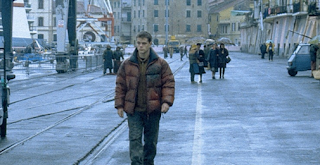
We used many props in our production, to make the film seem
more realistic. We used some flowers for the mourner to lay on the grave, as
this allowed us to portray what the actor was doing, without having to make it
clear in the voiceover. We also used a rope for the killer to tie the victim to
the train line with, along with a balaclava, to disguise his face both from the
camera, and from the victim. Furthermore, train planks were used to allow us to
write the titles/credits of the film onto the train. The planks gave an
authentic feel, and allowed us to move away from simply using titles on the
editing package – something that is done in a lot of thrillers, and by breaking
away from this convention, it would add the element of surprise to the
audience.
For our thriller opening, we used a track called ‘Gloom
Horizon’, available from royalty free music website www.incompetech.com. This was a track that mainly consisted of strings, with a strong beat
underneath the track, and an electric synthesizer effect was also added. From
all of the films we have watched, such as The Butterfly Effect, the music for
the opening section was quite a strong, punchy track, which was there to steal
the audience’s attention, and the pace of the music strongly reflected the pace
of the on-screen action. Therefore, we felt that this track would be entirely
appropriate for our thriller opening.
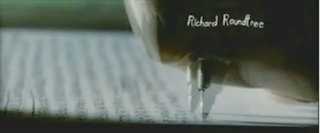 From the research that we had carried
out, we learnt that there are many conventions used to make the opening of the
thriller effective. One of the key elements of the opening, in my opinion, is
that it does not give too much detail away too soon within the film. For
example, the shot above is taken from the opening of Se7en, which often
features close up shots of objects, which makes the audience wonder what it is
actually showing. This ensures that the audience want to keep watching the
film, to see how it will develop.
From the research that we had carried
out, we learnt that there are many conventions used to make the opening of the
thriller effective. One of the key elements of the opening, in my opinion, is
that it does not give too much detail away too soon within the film. For
example, the shot above is taken from the opening of Se7en, which often
features close up shots of objects, which makes the audience wonder what it is
actually showing. This ensures that the audience want to keep watching the
film, to see how it will develop. 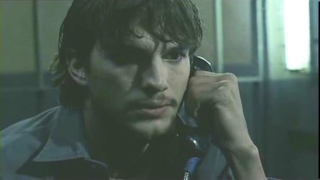 The use of flashbacks in film openings is also a technique
that we liked, and were interested to explore. We had seen this technique used
before, in the opening of The Butterfly Effect, where the main protagonist
could be seen being chased around an office, and being hunted down. At the
time, it was unclear why this was happening, but as the film developed, this
became more obvious. We used a flash-forward in our production, as the opening
we have produced is actually set around 20 years in advance of the rest of the
film. If the film had continued, we would be taken back to the time when the
victim and killer were only very young, to show how she was treated better than
him. The Butterfly Effect is something that we have definitely taken inspiration
from.
The use of flashbacks in film openings is also a technique
that we liked, and were interested to explore. We had seen this technique used
before, in the opening of The Butterfly Effect, where the main protagonist
could be seen being chased around an office, and being hunted down. At the
time, it was unclear why this was happening, but as the film developed, this
became more obvious. We used a flash-forward in our production, as the opening
we have produced is actually set around 20 years in advance of the rest of the
film. If the film had continued, we would be taken back to the time when the
victim and killer were only very young, to show how she was treated better than
him. The Butterfly Effect is something that we have definitely taken inspiration
from. 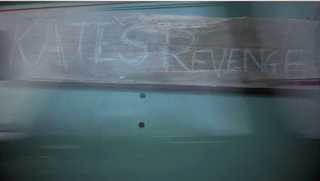 Often in film openings, straight cuts are used to edit the
shots together. This is a good technique to use, as it allows the action to
flow seamlessly, and portrays the fast pace of the action on the screen.
Together with the cross fade, this is a technique we used in our production. Above,
you can see the cross fade in use during our film. Also, the shots are edited
together very quickly, which is something we also tried to use. This technique
works well, because it allows the audience to feel as though they are part of
the action, and raises the adrenaline levels of the audience. Also, the trains
are known for running along the train tracks, so people associate these with
the train.
Often in film openings, straight cuts are used to edit the
shots together. This is a good technique to use, as it allows the action to
flow seamlessly, and portrays the fast pace of the action on the screen.
Together with the cross fade, this is a technique we used in our production. Above,
you can see the cross fade in use during our film. Also, the shots are edited
together very quickly, which is something we also tried to use. This technique
works well, because it allows the audience to feel as though they are part of
the action, and raises the adrenaline levels of the audience. Also, the trains
are known for running along the train tracks, so people associate these with
the train.
Sound is also something that features heavily in the opening
of thriller movies. Non-diegetic sound is almost always the overriding sound element.
Films often use violin/string music, as this works well with making the
audience feel nervous, and as though they are part of the action. This sort of
music was used in the opening of The Butterfly Effect, and also during the
opening of Se7en.
The openings of The Butterfly Effect and Se7en, are ones that
have perhaps inspired our production the most. We like the technique of not
giving much detail away during the film, and also the sound that was used in
these sorts of openings was not dissimilar to our opening.
Above: The Butterfly Effect
Above: Se7en Opening
Many of the conventions of a thriller mentioned above were
applied to our production. Firstly, our production used fast cuts in the edit
to create the feeling of fast-paced action. This helped to build up the feeling
of tension in the audience, and gave the impression that the film was building
up to a climax, where someone might be killed. It also adds to the sense of
confusion, which is also often present in thriller movies.
We have also used a variety of different shot types in our
production. Our shot list shows that our shot choice ranged from extreme close
ups, right the way through to the use of a mid-long shot, although in thriller
movies, long shots are rarely used, as the proximity offered by other shot
types allow the character’s emotion to be relayed to the audience. Furthermore,
the sound we used also had string instruments and drums in, again, something
that is typical of a thriller movie, and the voice we used for the narration
also sounded strong and powerful, which would instil fear in the audience.
Our setting for the film challenged convention, as it was set
at a rural train station, instead of in an urban area. The rural setting for
our thriller was comparable to ‘No Country for Old Men’ by the Coen brothers,
and I feel that this made our thriller unique, and stand out from other films of
a similar genre.
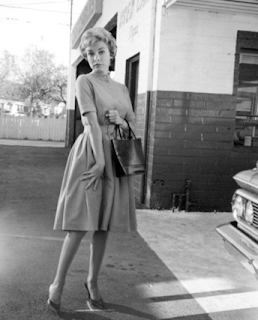
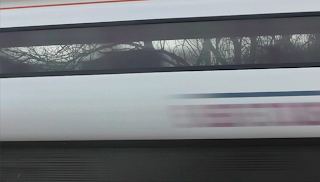 I feel that the cut away shots of the trains we used in our
production were a classic example of a convention used in thriller movies. The
shots were only very brief, and as the diegetic sound was played very high,
each time these train shots came on, it shocked the audience. The shots also
interrupted the narrative of the plot, which made the sequence seem more
interesting to watch.
I feel that the cut away shots of the trains we used in our
production were a classic example of a convention used in thriller movies. The
shots were only very brief, and as the diegetic sound was played very high,
each time these train shots came on, it shocked the audience. The shots also
interrupted the narrative of the plot, which made the sequence seem more
interesting to watch. 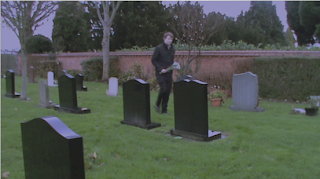 The setting of our production was very important. The
graveyard scene was set in the current time, whilst the train station scene was
a flashback – designed to show the thoughts of the mourner as he laid the
flowers. Graveyards are a typical setting for a thriller movie, and have been
used in many thriller movies, such as The Butterfly Effect.
The setting of our production was very important. The
graveyard scene was set in the current time, whilst the train station scene was
a flashback – designed to show the thoughts of the mourner as he laid the
flowers. Graveyards are a typical setting for a thriller movie, and have been
used in many thriller movies, such as The Butterfly Effect. 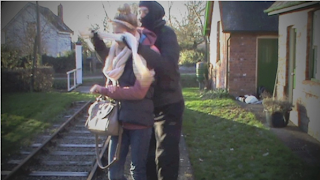
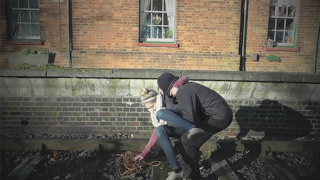 This next shot shows
how the victim was struggling, and that the killer had total control over the
girl. Also, our choice to use a mid-shot to film this section allows the
audience to gather a sense of location, as the railway and the train station
can clearly be seen in the background.
This next shot shows
how the victim was struggling, and that the killer had total control over the
girl. Also, our choice to use a mid-shot to film this section allows the
audience to gather a sense of location, as the railway and the train station
can clearly be seen in the background. 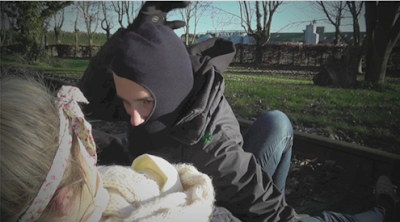 This shot clearly indicates the genre
of the film in the opening section. As the killer begins to remove his
balaclava, the audience get a sense that the film could be about the relationship
between these two people. The use of narration also indicates this throughout
the opening. This shot creates suspense within the audience, as the character
removes the balaclava in a very menacing and sincere way. However, it also
makes the audience intrigued, as they want to know how they are related, and
why the killer was trying to disguise his identity.
This shot clearly indicates the genre
of the film in the opening section. As the killer begins to remove his
balaclava, the audience get a sense that the film could be about the relationship
between these two people. The use of narration also indicates this throughout
the opening. This shot creates suspense within the audience, as the character
removes the balaclava in a very menacing and sincere way. However, it also
makes the audience intrigued, as they want to know how they are related, and
why the killer was trying to disguise his identity. 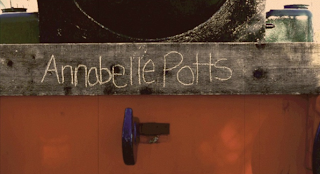 Throughout the film, as the new
actors are introduced, their name appears on a train track, written on by
chalk. This creates the effect that the names have actually been scratched into
the planks. This technique meant that we could avoid using the text overlay in
the editing package we used, as these titles are often quite over-used in
thriller openings. By doing it this way, it meant that we were breaking away
from normal convention, and using a technique that was relevant to the plot of
the thriller opening.
Throughout the film, as the new
actors are introduced, their name appears on a train track, written on by
chalk. This creates the effect that the names have actually been scratched into
the planks. This technique meant that we could avoid using the text overlay in
the editing package we used, as these titles are often quite over-used in
thriller openings. By doing it this way, it meant that we were breaking away
from normal convention, and using a technique that was relevant to the plot of
the thriller opening. 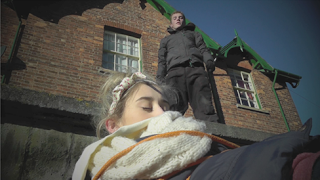 The shot on the left is perhaps my personal favourite in the
whole production. The shot was created by placing the camera on the floor, and
propping the front end of the camera up with a rock. The composition of the
shot means that the killer is standing over the victim, the low angle makes him
seem more powerful, and the dominant figure in the shot. The victim is
unconscious at this point, and she is tied up with a rope, which makes her seem
very vulnerable. Furthermore, the composition of the shot means that the killer
and the victim fill nearly the full height of the frame, whilst ensuring that
the train station is still visible, to remind the audience of the location.
The shot on the left is perhaps my personal favourite in the
whole production. The shot was created by placing the camera on the floor, and
propping the front end of the camera up with a rock. The composition of the
shot means that the killer is standing over the victim, the low angle makes him
seem more powerful, and the dominant figure in the shot. The victim is
unconscious at this point, and she is tied up with a rope, which makes her seem
very vulnerable. Furthermore, the composition of the shot means that the killer
and the victim fill nearly the full height of the frame, whilst ensuring that
the train station is still visible, to remind the audience of the location. 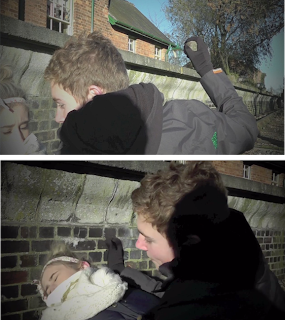 The two shots on the left also show good use of continuity
editing within our production. In total, the two shots were only shown for
three seconds, which shows that we used fast cuts when editing this sequence. This
is to give the impression that our victim was actually knocked unconscious by
the rock, although in actual fact, the rock never touched Annabelle’s face. This
is good evidence of our group using the filming-to-edit technique, which has
been seen in many thriller movies before. The bottom shot also uses the golden
mean, as the victim’s face, the rock and our killer’s face all fall on the same
diagonal line across the frame.
The two shots on the left also show good use of continuity
editing within our production. In total, the two shots were only shown for
three seconds, which shows that we used fast cuts when editing this sequence. This
is to give the impression that our victim was actually knocked unconscious by
the rock, although in actual fact, the rock never touched Annabelle’s face. This
is good evidence of our group using the filming-to-edit technique, which has
been seen in many thriller movies before. The bottom shot also uses the golden
mean, as the victim’s face, the rock and our killer’s face all fall on the same
diagonal line across the frame. 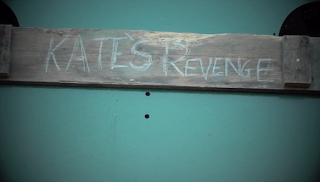 The title of our movie was also something that is quite
conventional for the thriller genre. Usually, the name of the main protagonist
is used in the title of the film, something that was done in the films The
Bourne Identity, The Bourne Supremacy and The Bourne Legacy, as all films star
Jason Bourne as one of the main roles. From watching our thriller opening, the
audience would probably correctly presume that the victim is Kate, who is
killed. However, because the film is called ‘Kate’s Revenge’, the audience
would be intrigued to find out how the film develops, and how she manages to
get revenge on her cousin. The way our title is presented in the film is also
quite conventional for the thriller genre. The title continues with the theme
that runs throughout the opening, with it being written onto the planks.
However, because it is written in chalk, it almost looks as though it has been
written as a child, and as the film develops to go back to the children’s
childhood, this is an appropriate way to present the title.
The title of our movie was also something that is quite
conventional for the thriller genre. Usually, the name of the main protagonist
is used in the title of the film, something that was done in the films The
Bourne Identity, The Bourne Supremacy and The Bourne Legacy, as all films star
Jason Bourne as one of the main roles. From watching our thriller opening, the
audience would probably correctly presume that the victim is Kate, who is
killed. However, because the film is called ‘Kate’s Revenge’, the audience
would be intrigued to find out how the film develops, and how she manages to
get revenge on her cousin. The way our title is presented in the film is also
quite conventional for the thriller genre. The title continues with the theme
that runs throughout the opening, with it being written onto the planks.
However, because it is written in chalk, it almost looks as though it has been
written as a child, and as the film develops to go back to the children’s
childhood, this is an appropriate way to present the title. 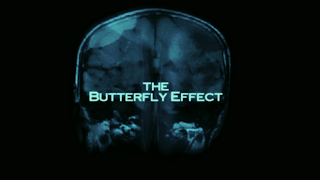 Furthermore, the way of presenting
the title in the centre of the screen with no other action around it is
something that has been done before in films. The film ‘The Butterfly Effect’
used a very similar technique, with the title in the centre of the frame, and
an appropriate background, a brain in this case, behind this. This shows that
our film followed many of the conventions of a typical opening.
Furthermore, the way of presenting
the title in the centre of the screen with no other action around it is
something that has been done before in films. The film ‘The Butterfly Effect’
used a very similar technique, with the title in the centre of the frame, and
an appropriate background, a brain in this case, behind this. This shows that
our film followed many of the conventions of a typical opening. 
No comments:
Post a Comment